An energy meter is used to measure and record electricity consumption in homes, shops, or industrial facilities. It is a fundamental tool for daily power management and electricity billing. With the advancement of smart home systems, modern energy meters not only display real-time power usage but also support remote reading, data management, and bidirectional energy measurement. Choosing the right energy meter helps users track consumption, avoid energy waste, ensure fair billing, and improve overall energy efficiency.
Key Considerations When Choosing An Energy Meter
- Power Supply Type: Single-phase or Three-phase?
Determine your electrical system type. Single-phase (220V) systems are common in residential homes, small offices, and shops—best matched with single-phase meters. Three-phase (380V) systems are used in factories, large equipment, or industrial environments, requiring a three-phase meter.
- Installation Method: DIN Rail Mounting?
DIN rail energy meters are compact and designed for standard 35mm rail mounting, making them ideal for distribution boxes. We recommend that models use DIN rail installation, ensuring easy replacement and maintenance.
- Display Type: Is the LCD Readable?
Traditional mechanical meters require manual reading and offer limited clarity. Digital energy meters feature LCD screens for intuitive, real-time readings. Some models come with backlighting for visibility in low-light environments. We recommend models with high-digit LCDs for easier daily use.
- Current Capacity: High Load or CT Input?
Meters are either direct-connected or CT-supported. Direct types like 40A or 100A are suitable for homes and small businesses. For high-load scenarios, choose models with CT input (e.g., 1.5(6)A), allowing current beyond 100A to be measured accurately.
- Communication: RS485/Modbus Support?
For users needing remote data access or system integration, RS485 communication with Modbus protocol support is essential. It enables integration into energy management systems for automated reading and data analysis.
- Measurement Type: Bidirectional Energy?
If your home or facility uses solar panels or other renewable sources, a bidirectional energy meter is necessary to measure both consumed and returned electricity. This is crucial for accurate energy accounting and calculating returns from distributed generation.
- Accuracy Class & Pulse Output
The accuracy class defines measurement precision. Tool.com meters typically offer Class 1 accuracy, suitable for billing-grade applications. Some models provide high-frequency pulse outputs (e.g., 800 imp/kWh), which are ideal for data collection systems.
Which Energy Meter Is Right for You?
Home Users (Standard Use, No Generation)
You may rely on a standard 220V single-phase power supply and have relatively moderate electricity loads spread across lighting, appliances, and HVAC systems. What you need is an energy meter that is easy to install, straightforward to read, and capable of handling everyday usage without unnecessary complexity. The following two models meet your exact needs, with compact size, clear displays, and optional communication features, making them especially well-suited for residential environments.
| Single-phase Digital Energy Meter | Single-phase Digital Energy Meter with LCD |
 |
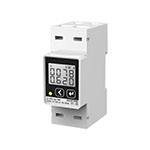 |
Features:
- The two energy meters are designed for 220V single-phase power systems, making them ideal for typical residential setups.
- They can handle current ratings of either 5(40)A or 5(100)A, accommodating various household energy demands.
- Equipped with an LCD, they provide clear and easy-to-read measurements of your electricity usage.
- Their compact design allows for convenient DIN rail mounting, facilitating straightforward installation in your home's electrical panel.
- Additionally, some models offer optional RS485 communication and pulse output features, enabling integration with home energy management systems or external monitoring devices.
Small Shops or Office Users (Higher Loads)
If you run a small shop or office, you likely deal with higher loads from equipment like lighting, computers, air conditioning, or refrigerators. In this case, you may want an energy meter that can handle more current, give you precise readings for tracking costs, and possibly connect to a smart monitoring system. The product below is designed to meet your needs.
Single-phase Digital kWh Meter
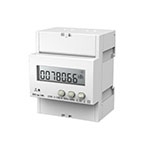
Features:
- It supports direct input up to 100A, and if your load goes beyond that, you can use a current transformer (CT) for extended capacity.
- The large 7-digit LCD with backlight makes it easy to read data clearly—even in poorly lit utility rooms or back offices.
- Its high measurement accuracy ensures reliable billing or internal cost control.
- With RS485 communication and support for Modbus-RTU and DL/T645 protocols, you can integrate it seamlessly into your energy management or remote monitoring systems.
Industrial or Factory Users (Three-phase Supply, Heavy Equipment)
If you manage an industrial facility or factory, your power needs are far more complex. You likely rely on a three-phase supply to run heavy-duty equipment like motors, HVAC systems, or large-scale lighting. In this kind of environment, you need a robust energy meter that can handle high loads, track detailed power metrics across all phases, and integrate with your energy monitoring system. The following models are built to meet those demands.
| Three-phase Digital Energy Meter | Three-phase LCD Display Energy Meter |
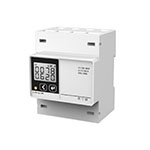 |
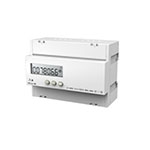 |
Features:
- The two energy meters support both three-phase four-wire (3×230/400V) and three-wire (3×400V) power systems, giving you flexibility depending on your setup.
- They can handle up to 5(100)A directly or use CT input for even larger loads.
- With their LCD displays, you can view real-time values for voltage, current, and power across all three phases.
- Their high accuracy ensures reliable energy tracking, while RS485 and pulse output make them easy to connect to centralized monitoring or building automation systems.
Solar Users (Bidirectional Energy Measurement)
Solar-powered facilities and buildings that feed electricity back into the grid require more than just standard energy monitoring. In these setups, bidirectional measurement is crucial—not only to track how much energy is consumed, but also to monitor how much is being exported. The model below is purpose-built for such applications, especially where high current loads and system integration are involved.
Three-phase Digital kWh Energy Meter with CT Input
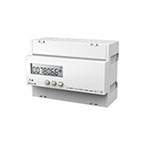
Features:
- This energy meter works with current transformers (CT) to measure high current loads in three-phase power systems, making it ideal for industrial-scale setups.
- It supports bidirectional measurement, so you can monitor both imported electricity and the energy you feed back into the grid.
- The 7-digit LCD provides clear, precise energy readings, even in complex systems.
- With RS485 communication and a high-resolution 800 imp/kWh pulse output, it integrates easily into remote monitoring platforms or smart energy management systems.
At Tool.com, you'll find a wide range of DIN-rail digital energy meters made to suit everything from home setups to commercial buildings and industrial sites. Choosing the one that matches your actual power needs means you’ll get more accurate readings, manage energy more efficiently, and save money in the long run.

